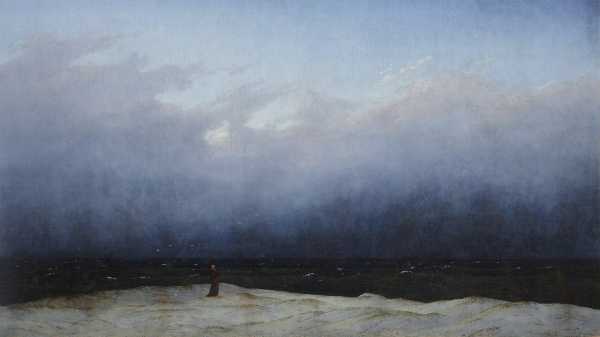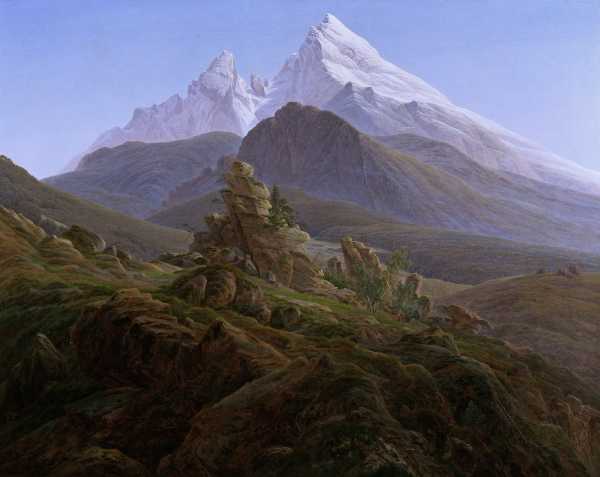
Save this storySave this storySave this storySave this story
Heinrich von Kleist, the German writer, once said that looking at a seascape by Caspar David Friedrich was like having your eyelids cut off. You were staring directly at death, at the loneliest center of the loneliest void. What could be better than that? A visitor to Friedrich’s studio, Helene von Kügelgen, suggested that the same painting would be less frightening if he put a sea monster in it. Anything to mitigate the loneliness. “Indeed, a thunderstorm would have consoled and delighted me,” she said. It was as if Friedrich had uncorked a drain at the bottom of the canvas and let everything vital spill out.
The painting in question, “The Monk by the Sea” (1808-1810), along with its pendant, “The Abbey in the Oakwood” (1809-1810), are the centerpieces of a bewitching new Friedrich retrospective at the Alte Nationalgalerie, in Berlin. The occasion is a slightly random jubilee: the two-hundred-and-fiftieth anniversary of Friedrich’s birth. Across Germany this year, there are exhibitions in Hamburg and Dresden, and more than a hundred and sixty events in Friedrich’s home town of Greifswald. There’s even a “Cake for Caspar” birthday party. For Kant, they didn’t roll out the red carpet until he was three hundred.
How did a man who painted foggy mountains and sunsets become the greatest German painter of the nineteenth century? The answer turns roughly on the year 1810, when Friedrich produced the two masterpieces now in the Alte Nationalgalerie. If you had to choose a single moment when painting became “modern,” you could do worse than choose the night—it had to be night—when Friedrich stepped back from “The Monk by the Sea,” in his studio in Dresden, and used a brush loaded with smalt blue to paint over three ships in the background. A simple act of subtraction—that was it. What remained: monk, dunes, sea, sky, and a few minimalist gulls. Even without looking at an infrared reflectogram, the paint is thin enough that you can see, up close, the faintest hint of the masts and rigging. What might have been a slightly creepy marine painting was turned into a portrait of the most impossible thing in the world to represent: emptiness.
“The Abbey in the Oakwood,” cut from the same bolt of canvas, trades in the emptiness for an actual funeral. A cortège of monks trickles into the portal of a ruined abbey, under a row of bare oak trees. There is a kind of capillary action at work here, as the light is sucked out of the sky by spindly branches. In the foreground, Friedrich has installed one of his go-to tropes: an open grave. Compare this with a neoclassical landscape by Pierre-Henri de Valenciennes, in France, or with the work of Joseph Anton Koch, Friedrich’s peer in Austria. Instead of placing you in a nice meadow with half-naked nymphs and plump sheep, Friedrich shoves you into a cold, dark pit.
Spend enough time in Friedrichland and you pick up on a trend in the iconography. A door is death, scissors are death, poplars are death, oak trees are death, the night is death, and boats are coffins. Rocks might symbolize faith, and moons hope, but the moment that the rocks are cairns, or the moon is a sickle, you’re out of luck again: death. When Friedrich was barely thirty, he was already inscribing his own name on crosses in his drawings: “Here rests C.D. Friedrich in God.”
The standard diagnosis for Friedrich’s angst involves a childhood accident. In 1787, at the age of thirteen, after already losing his mother and a sister, Friedrich and his younger brother Johann went out skating on a frozen moat. One version has it that Caspar fell in first, and that Johann died saving him. Another is that Caspar watched as his brother drowned. Either way, the plot writes itself: he became an artist who spent his life restaging this primal scene in one canvas after the next—reckoning with the sublime violence and wonder of the natural world. The Austrian writer Adalbert Stifter, Friedrich’s contemporary, imagined a moment in which “the beautiful silver mirror of a river swells, a boy falls in, the water ripples sweetly around his locks, he sinks—and after a short while the silver mirror swells as before.” It was not the death that was beautiful but the indifference of nature.
Growing up in Greifswald, on the Baltic coast, Friedrich was no stranger to the power of water, the sea having swallowed up Hanseatic merchants and Dutch fluyts by the thousands. Even though nature was vast and terrifying, Friedrich loved painting landscapes because they brought him closer to God. Every speck of dust and particle of moisture was endowed with His presence, and the painter was the medium through which He flowed. The task was to find the spiritual quiddity of God’s gifts in nature, piece by piece, and to assemble them into a divine whole.
In 1809, Friedrich’s budding pantheism landed him in hot water. Basilius von Ramdohr, a conservative art critic, published a long piece railing against Friedrich’s “Cross in the Mountains,” or “Tetschen Altar.” Every square inch of the canvas violated the principles of landscape painting. The butchering of perspective, the nonexistent foreground, the sapping of color and light—all of it was wrong, Ramdohr wrote. And Friedrich had planted the crucifix in the distance, all the way on top of a mountain, like a toothpick in a muffin. It was not befitting of the glory of Christ. Nor was it proper for lowly landscape painting to be put to the task of religious devotion, “to slink into the church and creep onto the altar.” The piece deepened the fault lines between Friedrich, the Romantic prince of sublimity and feeling, and the fusty rationalists who preceded him. In his tart reply, Friedrich mocked Ramdohr for lacking spirit: “You who are nothing but body!”

“The Abbey in the Oakwood” (1809-1810).
The Alte Nationalgalerie is missing “Tetschen Altar” and Friedrich’s “Wanderer Above the Sea of Fog” (1818), the most famous man’s back in the history of art, but the show is fine without them. The exhibition has more than a hundred works by Friedrich. They include, in addition to the “Monk” and “Abbey,” three other masterpieces: “Chalk Cliffs on Rügen” (1818), “The Sea of Ice” (1823-24), and “The Watzmann” (1824-25).
The clear highlight—and surprisingly so—is “The Watzmann.” It’s not as symbolically dense as “Chalk Cliffs,” but I don’t think I’ve ever seen a more bracing landscape painting in person. It makes your mind feel as if it’s chewing on a mint. Friedrich has somehow reversed the laws of aerial perspective, which typically requires sharpness in the foreground and an increasing blur as the landscape recedes, to give the illusion of depth. Here, the foreground is muddy and dark—a soup of ill-defined umbers and greens. And then, layer by layer, you move from rock piles to rolling blue-green hills, to grayish mountains, and finally to white peaks, which are so snappily painted that they seem athletic and weightless, despite their bulk.
As usual, Friedrich discards all painterly common sense. Right in the middle of the canvas, there are about six vertical peaks competing for your attention, a compositional nightmare. There’s also nowhere to imagine yourself standing. If you squat in front of the picture, you can find something like a vanishing point, but if you look at it dead on, you would have to be hovering at least five or ten feet above the rock. So you’re basically on your way to Heaven, which is what it feels like to look at this. Heaven.
Friedrich never travelled to the Berchtesgaden Alps to see the mountain called the Watzmann. In fact, he almost never left Germany—something unheard of for a major landscape painter from the period, a trip to Italy being a requisite part of one’s education. But even if you aren’t a seasoned alpinist, you can tell right away that something is askew. The wacky rocks in the middle ground, the wavy hills—none of this belongs in the Alps. It’s a composite, like almost all of Friedrich’s work. But “composite” isn’t quite the right word, because Friedrich didn’t simply take a few plein-air sketches and tack them together. He would age things hundreds of years or burn them down or scramble them. One of the revelations of the show, and maybe the most easily overlooked piece, is “Nine Sketches of a Rowboat” (1806). It’s a pencil study of a rowboat viewed from different angles, each as odd as the next—little half-turns where Friedrich tips the boat this way and that, so it can be seen leaving and arriving and turning all at once. It’s a beautifully concise portrait of a mind at work. Friedrich could imagine the full life cycle of a thing, seeing not only a coastline or a tree but dispersing it into multiple versions of itself across time.

“The Watzmann” (1824-25).
Ever since Friedrich was revived in the early twentieth century, he’s been savored as the most German of German artists. Whereas classicists such as Johann Winckelmann looked to the work of ancient Greece and the Mediterranean, and painters like the Nazarenes moved to Rome, Friedrich barely went south of Dresden. He hated Napoleon and the French so much that he refused to receive letters from his brother Christian when he was travelling in France. He chided the painters who were “no longer satisfied with our German sun, moon and stars, with our rocks, trees and plants, with our plains, lakes and rivers.” Before the German nation-state even existed, Friedrich was a hard-core nationalist.
You can probably see where this is going. The first major monograph on Friedrich appeared during the First World War; the title was “God, Freedom, Fatherland.” A few decades later, Friedrich’s Romantic zeal made him popular with the Nazis. (Hitler reportedly loved Friedrich.) The reputational dry-cleaning started in the late nineteen-fifties, when the Council of Europe folded him into an exhibition on the broader international currents of Romanticism, but the real turning point was the seventies, when there was a bloom of scholarship on both sides of the Atlantic, spurred partly by the bicentenary of Friedrich’s birth. The most influential study from this period came from the American art historian Robert Rosenblum. His provocative classic “Modern Painting and the Northern Romantic Tradition” rerouted the history of modernism around Paris, and installed Friedrich and Rothko as the “the alpha and the omega” of modern painting.
Friedrich has always been a screen onto which other people, art historians and artists alike, project their own designs. Look at Caroline Bardua’s portrait of Friedrich alongside two others by Georg Friedrich Kersting, and then place those next to Friedrich’s self-portrait from 1810. They were all done within a few years of each other, and yet you find yourself looking at three completely different men. In one, he looks like a sea-bitten naval officer; in another, like an old man shuffling cutely around his studio in his slippers; in another, he’s a disgruntled monk who’s leapt over the monastery wall and is on the lam. It seems fitting that one of Friedrich’s signatures was the Rückenfigur, a person in the foreground who looks out toward the horizon, the broad plane of their back an invitation for us to project ourselves into the painting. The Rückenfigur is not a distinct person so much as an anonymous vehicle for the production of feeling. Even as we imagine what they feel, we are encountering ourselves in duplicate—yawing between sunrises and shipwrecks, mountains and the sea. ♦
Sourse: newyorker.com